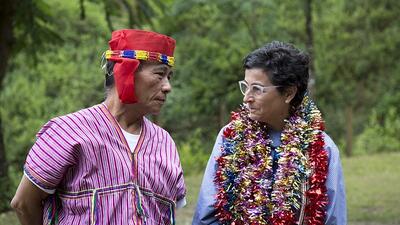
From Kayah to Tanintharyi: expanding inclusive tourism in Myamar (en)
How to share the local traditions of remote communities with tourists whilst also safeguarding their culture and well-being? What roles make up a successful community tourism club? What do tourists expect when travelling to remote places? These are some of the issues addressed by the study tour to Myanmar’s Kayah state organized for 35 participants from the Tanintharyi region where the International Trade Centre works to diversify and improve the inclusive tourism offer under its NTF IV Inclusive Tourism project.
In September 2018, the group of trainees travelled nearly 800km up north on an inclusive tourism adventure from Dawei, the capital of the Tanintharyi region, to Loikaw, the capital of Myanmar’s smallest state: Kayah. Swapping their untouched landscapes of sandy beaches and turquoise waters for agricultural and spiritual green hills, the group followed an intensive schedule of visits and workshops prepared by the ITC-trained Kayah tourism team.
Training a cohort of trainers: a Kayah-Tanintharyi knowledge exchange
Whilst consolidating its existing work in Kayah state which began in 2013, ITC is now expanding its inclusive tourism methodology to the Tanintharyi region. ITC implements a learning process of “training of trainers” (TOTs) to professionalise local tourism workers and build local capacities. Once trained, the TOTs are able to help their communities of origin to develop tourism in a sustainable way.
The five day immersive study tour was organised by ITC’s trained Kayah TOT team for the Tanintharyi participants. The newly formed Tanintharyi TOT group is composed of 24 tourism workers from diverse backgrounds - including tour operators, guides, receptionists, village communities and NGO staff - representing the three main districts of Tanintharyi and they were accompanied by 11 governmental representatives from Myanmar’s Ministry of Hotels and Tourism.
The training focused on learning by experience and encouraged trainees to think about adapting and replicating their learnings to the Tanintharyi region. The group learned how to develop community based tourism which benefits local communities whilst responding to tourists’ needs: one of the many aspects of ITC’s Inclusive Tourism approach. Htet Arkar Latt, a coordinator at Htone Khar Community Learning Center from Tanintharyi says, “On this study tour, I learnt all the processes of community based tourism and I got ideas for Tanintharyi.”
Learning through experience: stepping into tourist’s shoes
Far from being a five-day holiday, trainees were divided into four groups and each was set an observation assignment to present to the entire group and trainers on the last day. Community based tourism products and experiences, tourists and marketing, management and the positive and negatives outcomes of these were the four subjects addressed.
Stepping into the shoes of their future customers, the trainees participated in an array of activities which ITC has developed since 2013. Guided by ITC’s local team, this included a visit to the Loikaw Museum, learning the art of local weaving, trekking in Hta Nee La Leh and visiting local monuments such as the Kaetoebu totems. Through these visits, the group gained an understanding of the varied types of activities tourists enjoy and note what makes them a success.
Trainers pushed trainees to consider the entire tourism ecosystem and the variety of interactions taking place within it. The members of Kayah tourism clubs have different roles and their responsibilities vary from doing bookings, receiving cash to structuring tours. Non-governmental organisations also contribute their experience working with remote communities and in respecting the local environments. Local governments are involved in the development of tourism products from the selection to the promotion of locations and activities. The group saw how throughout the tourism chain, every person plays a determined role.
Kayah state: an example to follow
During the study tour, the Kayah tourism trainers showcased their skillsets. They surpassed ITC expectations showing initiative: the village of Pan Pet welcomed the group with a traditional dance which was avidly videoed on trainees’ smartphones and shared online and the new instructor at the peppered sausage attraction was commended for his clear instructions. Peter Richards, an ITC cultural tourism expert stated “We are so proud of the Kayah team, they worked really hard to prepare the study tour and put in 100% effort, facilitating many of the sessions themselves.”
A panel discussion composed of Kayah community members, government representatives and local regional guides was organised to give the Tanintharyi trainees an opportunity to ask in depth questions. Htet shares his takeaways from the panel: “I learnt how the government supports tourism, I understood the relationship between local ground-handlers and regional guides, how local tour companies promote markets and how ITC makes CBT a reality in Kayah.”
The five star quality of the study tour was revealed in the enthusiasm of the Tanintharyi trainees and their informed presentations were a statement of their commitment and motivation to apply the knowledge learnt to develop inclusive tourism in their own region.
Indeed, Htet returned home with many ideas: “In Tanintharyi, the products will not the same with Kayah but there are a lot of natural resources like the beach, rainfall and forest. Therefore, we have to focus on community based ecotourism. Similarly to Kayah, we can welcome with our traditional dance and bring tourist to the beach and show traditional fishing.”












